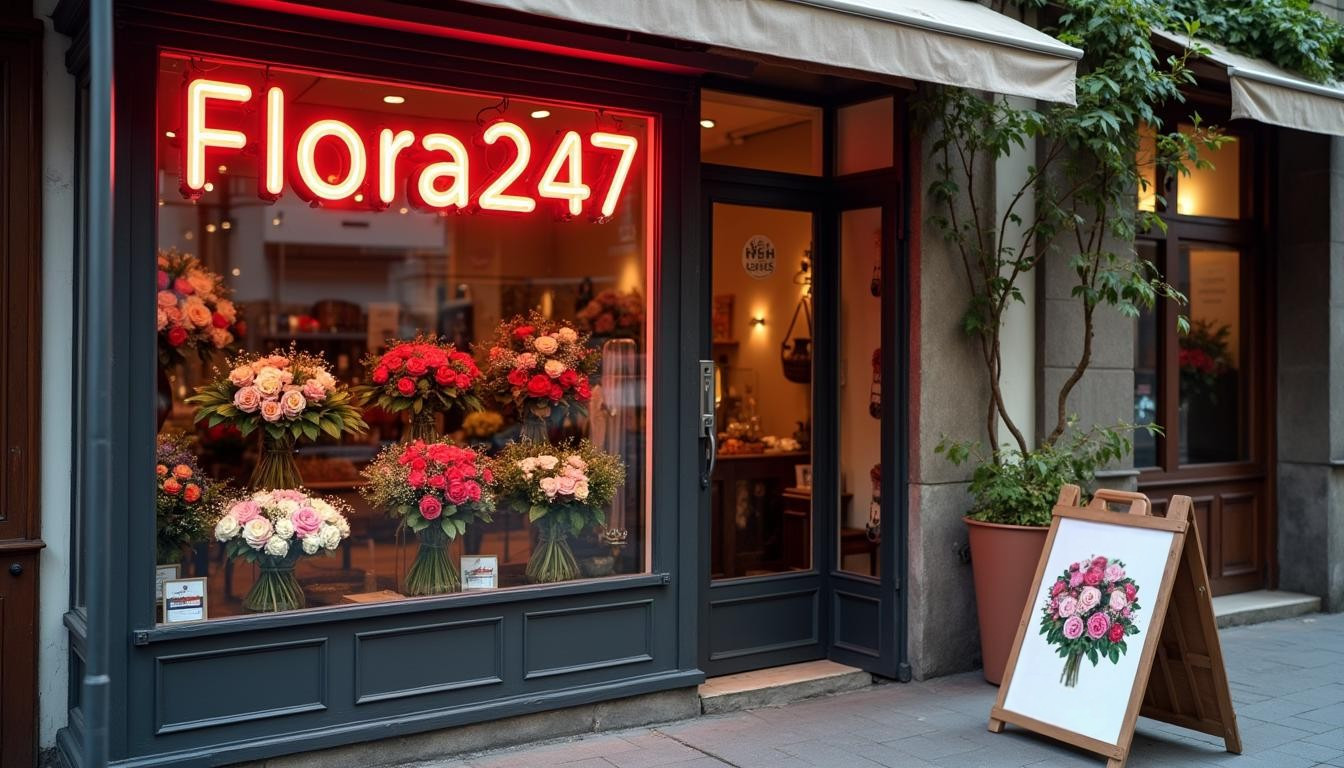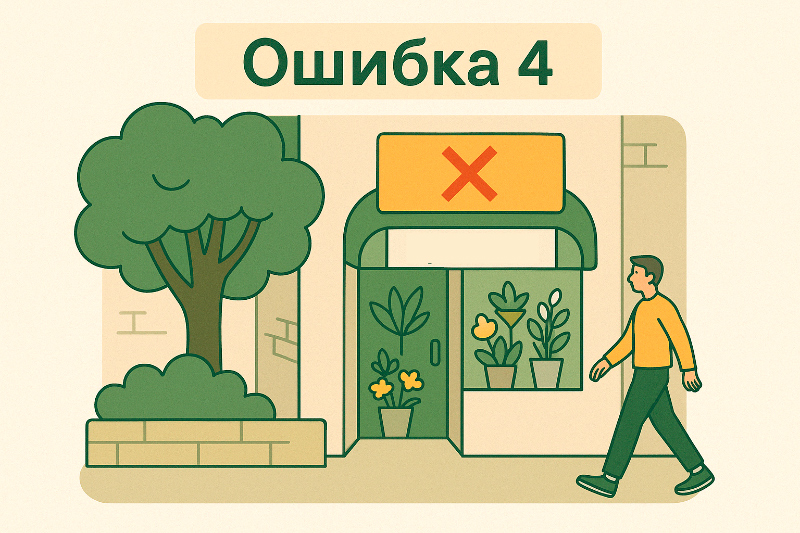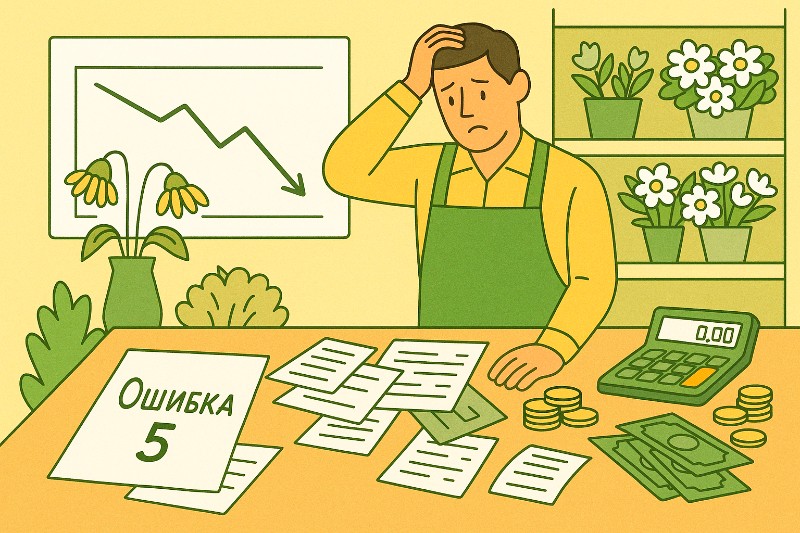
5 Common Mistakes New Flower Shop Owners Make — and How to Avoid Them
Why Newcomers Struggle in the Floral Business
The Reality of the Floral Market in Russia
The flower business in Russia isn’t just about the beauty of bouquets — it’s a tough and competitive environment. In 2023, research showed that over 4,000 flower shops shut down in just three years — nearly 18% of all existing shops, according to RIA Novosti. The most difficult period came in December 2020, when 1,407 stores closed their doors. The pandemic hit sales hard, and those who failed to pivot online were left behind. But it wasn’t just COVID to blame — many newcomers sabotage their own chances by skipping market research, underestimating competitors, and making avoidable mistakes. In smaller towns, shops disappear due to a basic misunderstanding of local demand, while in big cities, they’re pushed out by faster, savvier players. These aren’t just statistics — this is a warning for anyone entering the game.
How This Article Can Help Your Business
This article breaks down five common mistakes that new flower shop owners make. Each one is illustrated with real examples, and the advice is practical — clear steps to help you avoid the same pitfalls. You’ll find a roadmap here for building a stable business that won’t shut down in six months. Direct sourcing through marketplaces like Flora Market can also make a big difference — more on that later.
Mistake 1: Ignoring Your Customer Base

Why It's a Problem
You can’t rely on walk-ins alone in the flower business. For shops that have found their niche, up to 80% of revenue comes from returning customers. Without them, revenue is unpredictable — a rush one day, crickets the next. Flowers aren't just for holidays — they’re for birthdays, anniversaries, weddings, or just-because moments.
One shop hovered at the break-even point for a year before it became clear that rent was swallowing any profit due to the lack of a loyal client base. Another store saw sales drop simply because it failed to stay in touch during peak seasons. Without repeat sales, you lose consistency — and become vulnerable to dips in demand.
The Root Cause
It starts with neglecting to collect data. Customer details — names, phone numbers, preferences — are often overlooked, even though they could be key to bringing people back. Add to that the silence at critical times — before March 8th, September 1st, or New Year’s, when some stores fail to send even a basic reminder. It’s like a restaurant that never tells customers about a new menu — people go where they’re invited. Many owners believe their customer base will build itself over time, but without effort, it stays empty and growth opportunities slip away.
How to Fix It
Building a contact list isn’t hard if you stay organized. Ask for a name and phone number with every order — using a paper form, a message on a messenger app, or just during a conversation. Sending a quick message on Telegram or WhatsApp takes minutes — something like “Fresh tulips just arrived for the holiday!” can grab attention fast.
Small incentives go a long way — a discount on the next order, a free card, or complimentary wrapping. Loyalty cards are a simple and effective way to boost repeat sales.
Here are some easy wins:
- Start small. Even a list of 20 contacts can make a difference.
- Use a calendar of key dates. Reminders before holidays are highly effective.
- Make it personal — addressing the client by name increases response. This isn’t about fancy CRM systems, it’s about care and consistency.
Mistake 2: Poor Market Positioning

Why It's a Problem
If your shop offers bouquets for 5,000 rubles in a neighborhood where people are looking for options in the 500–700 range, they’ll go elsewhere. In 2022, misaligned pricing and product positioning cost flower shops an estimated 9–13% in lost sales, according to T-Bank. One shop offering exotic flowers in a suburban area didn’t survive even six months — locals preferred simple chrysanthemums over overpriced orchids. Another premium-focused store failed to attract attention in a middle-income residential area.
It’s like trying to sell designer fashion at a train station market — ambitious, but doomed. The market sets the rules, and ignoring them means losing potential customers before they even walk in.
The Root Cause
The problem usually comes down to rushing in without research. Without analyzing your audience, your product range becomes a random mix of flowers that no one asked for. Factors like age, income, and local habits go ignored — and the outcome is predictable.
Offering luxury roses in a student district? Don’t expect stable sales — students prefer bright, affordable gerberas. Go all-in on exotic arrangements? You might miss the mark if the locals are shopping for family event bouquets on a budget. You can’t guess the demand — you have to study it. But many skip this step, relying on instincts or trends instead.
How to Fix It
Start by studying your surroundings. Walk around the neighborhood to see who lives and works there — young families, retirees, office workers of various income levels. Local community chats, social media, or even conversations with neighbors will reveal what people buy and how much they’re willing to pay. Tailor your product range accordingly: in residential districts, roses for 100–170 rubles a stem sell well; in upscale areas, go with lilies, anthuriums, or orchids.
Testing helps clarify things:
- Launch a few bouquet options via delivery and see which ones get ordered.
- Post photos on social media and gauge the reaction — it only takes a day, but the insights are invaluable.
- Start with a small assortment and expand based on demand. Try hatbox flowers, mini-bouquets, mono-bouquets, or flower baskets.
Direct sourcing from plantations gives you flexibility — you can experiment with pricing and selection without overextending your budget.
Mistake 3: No Consistent Marketing Strategy

Why It's a Problem
If your shop doesn’t speak up, no one knows it exists. In an era where delivery services and online platforms dominate attention, staying silent is a costly mistake — up to 30% of potential customers will choose businesses that are more visible. A flower shop can survive on random orders, but competitors nearby are steadily capturing market share through social media and map listings — and eventually push quieter shops out.
Another example: a boutique with a great selection might stay invisible simply because it didn’t invest in promotion. In the floral business, silence isn’t humility — it’s a shortcut to failure, especially when there are so many ways to get noticed.
The Root Cause
Some owners assume customers will find them naturally, but without visibility, it just doesn’t happen. Consistent traffic comes only after consistent outreach. Another common issue: scattered, unfocused marketing efforts.
Spending 10,000 rubles on a random post in a local VK group that no one sees doesn’t count as promotion. Random actions without a plan or understanding of channels burn money without results. Marketing isn’t a one-off blast — it’s a system. And many underestimate that.
How to Fix It
You don’t need a massive budget to get started with marketing — just a few simple, consistent steps can make a real difference. Here’s what you can do:
- List your shop on Yandex Maps, Google Maps, and 2GIS — it’s free, and people walking nearby will start noticing you.
- Create a page on VKontakte or Telegram: regular photos of fresh bouquets, special offers, and short behind-the-scenes videos grab attention and spark interest.
- Partner with nearby businesses like cafés, beauty salons, or yoga studios — swapping flyers or business cards helps bring in their foot traffic.
- Post in local chats or community groups — that’s where people often look for recommendations.
- Use seasonal opportunities: a post before International Women’s Day or Teacher’s Day featuring themed bouquets can bring a surge in orders.
You can get orders just by leaving flyers at the coffee shop next door. And high-quality photos of your arrangements on social media — that’s a must-have.
Direct sourcing from flower farms gives you a serious advantage — a unique product line is easier to promote and stands out from the generic offerings. Don’t wait for people to talk about your shop — start the conversation yourself and build a system that delivers consistent results.
Mistake 4: Choosing the Wrong Location

Why It's a Problem
A flower shop tucked away in a basement or on a low-footfall street is going to struggle for every customer — especially during the crucial first months, when no one knows about it yet. Without natural traffic, sales are hit-or-miss, and you don’t get the chance to build a reputation. A store hidden in a courtyard might save on rent, but customers may never find it. Even a great product range can’t make up for the lack of visibility — especially if your business depends on offline sales.
In the early stages, location is everything — it’s the magnet that pulls people in. If there’s no magnet, there’s no flow.
The Root Cause
Often, business owners pick a location at random, without analyzing key factors. They don’t count foot traffic or evaluate nearby competitors. Then there are the “small” issues that end up making a big difference: a storefront hidden behind trees or billboards, no parking for drivers, or a difficult entrance. Missing signage is another deal-breaker — people walk right by without even realizing there’s a flower shop there. All these little things add up and become a barrier that keeps potential customers away.
How to Fix It
Your location decision should be based on observation and planning. Choose areas with steady foot traffic — near shopping centers, office buildings, or public transport stops — for better odds of success. You don’t have to rent in the city center at sky-high rates. What matters is visibility from the street and easy access.
Before signing a lease, scout the area:
- Count how many people pass by in an hour at different times of day.
- See where people tend to gather — near intersections, stores, or cafés.
- Check whether established competitors are nearby.
A bold, clear sign is your first line of communication with passersby — without it, your shop fades into the background. If foot traffic is weak, focus on delivery: that can keep you afloat through messenger orders while you save up to relocate somewhere livelier. The key is to make calculated choices — your location either works for your business or works against it.
Mistake 5: Poor Financial Management

Why It's a Problem
Without financial control, your business becomes unstable — and it burns out fast. Selling a bouquet for 1,000 rubles that costs you 1,150 means you're losing 150 per sale. Multiply that by 50 orders a month and you're down 7,500 — and you might not even notice unless you're tracking your numbers. Often, flower and rent expenses eat up all the revenue. In other cases, shops over-order and end up writing off excess inventory — a steady drain on the budget.
In the flower business, margins are thin — typically between 20% and 40% — and if you’re not tracking them, losses aren’t a matter of “if” but “when.” Without financial transparency, even a promising concept turns into a sinking ship.
The Root Cause
It usually starts with sloppy bookkeeping. Owners may only track big-ticket items like bulk rose orders for 5,000 rubles, while ignoring utility bills, packaging, or transport costs. In many cases, they don’t track anything at all — income and expenses are estimated by gut feeling, creating the illusion of profitability where none exists. Another pitfall: failing to analyze profitability. Flowers that sell well in one season may rot in storage the next. Not knowing which items are profitable and which are dragging you down becomes a habit — one that can get very expensive.
How to Fix It
Financial discipline is built on small, consistent habits. Here’s what helps keep your cash under control:
- Use Excel or Google Sheets to record every purchase, sale, and expense — from stems to ribbons to electricity.
- Calculate the real cost of each bouquet, including not just materials, but also florist time, delivery, and rent per order.
- Review your balance weekly: compare income and expenses to get a clear picture.
- Track inventory: how many stems were sold vs. discarded — to avoid overbuying.
- Analyze profitability: double down on what sells and cut what doesn’t.
Simple bookkeeping tools are enough for a small business — from free apps to low-cost platforms like MoySklad that automate routine tasks and reduce error risk. Knowing your purchase prices also matters: it helps you set the right margins and avoid financial surprises. Control isn’t about complexity — it’s about building habits that protect you from loss and open the path to sustainable growth.
Conclusion: How to Build a Successful Flower Business
The flower business isn’t about luck — it’s about making smart, deliberate moves. A solid customer base creates a reliable foundation. Market fit ensures your products meet real demand. Marketing brings your shop out of the shadows. The right location attracts walk-ins. And financial control prevents losses. Each of these is a link in the chain — if one breaks, the whole system wobbles. Skipping even one of them puts your profits, time, and peace of mind at risk. Those who pay attention to these areas don’t just survive — they grow. The market doesn’t forgive mistakes, but it rewards those who are ready to avoid them.
You don’t need bold promises or a complicated plan to get started. Pick one idea — maybe collecting customer contacts, analyzing demand, or tracking your expenses — and try it in practice. Small steps lead to big results. Your shop will become more visible, more profitable, and more resilient. Buying directly from flower farms through platforms like Flora Market gives you an edge: lower costs open up room for flexible pricing and a wider range — a real trump card in a competitive market. What matters is staying in motion — the market moves fast, and success goes to those who move with it. Stability and growth start with the decisions you make today.
What’s Next?
Avoiding mistakes is just the beginning. The next level is finding your niche, standing out from the competition, and building systems that run smoothly without your constant oversight. The flower business can be both profitable and fulfilling — if you approach it wisely.
Every point in this article is a tool you can adapt to your situation — your shop size, your city, your audience. The key is not to stay stuck in theory. Action turns knowledge into results — and results build confidence. The market is waiting for those ready to adapt and claim their place.











